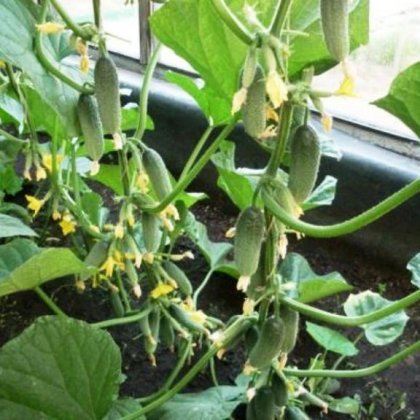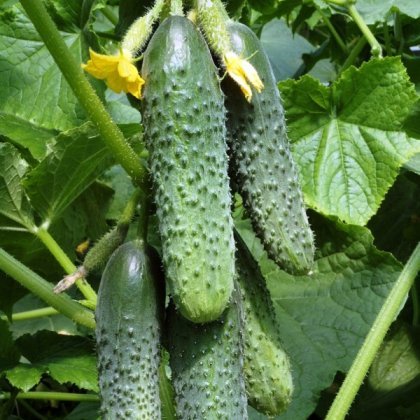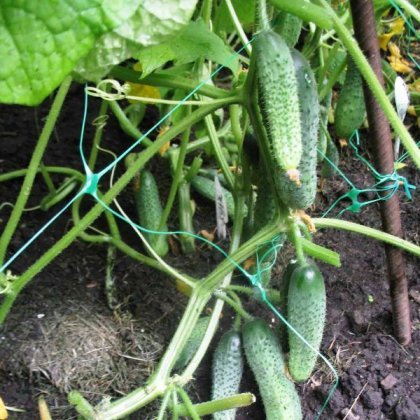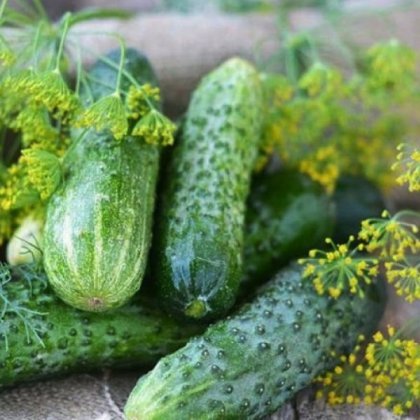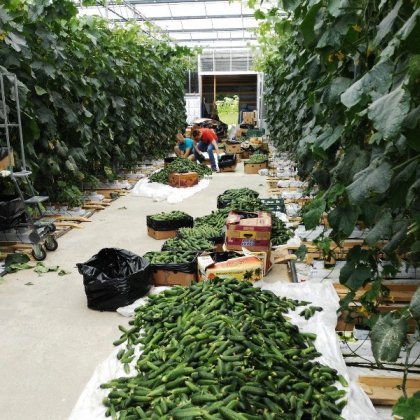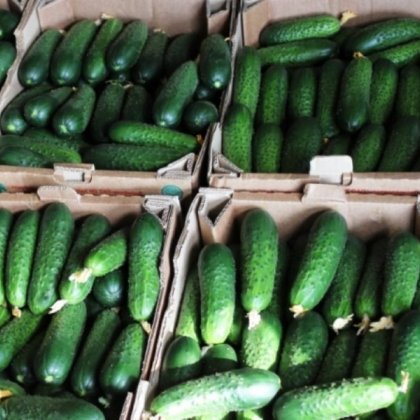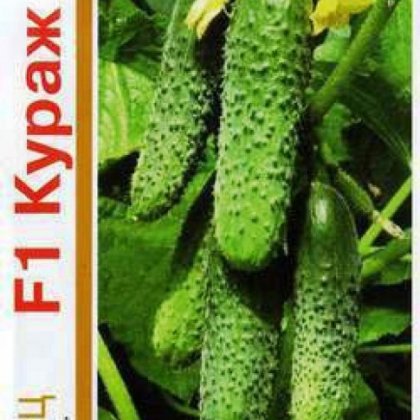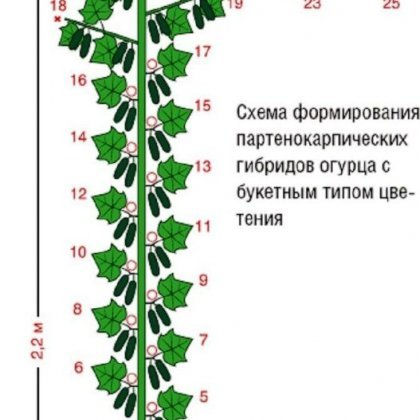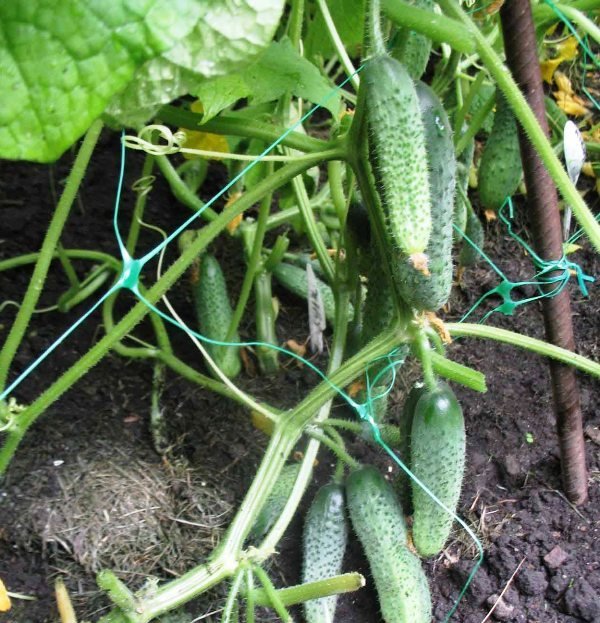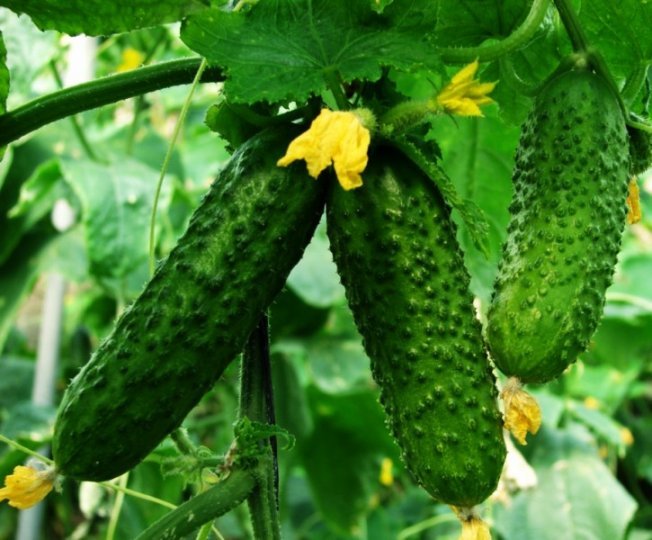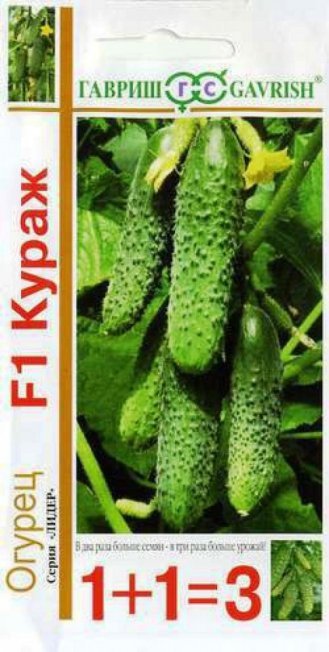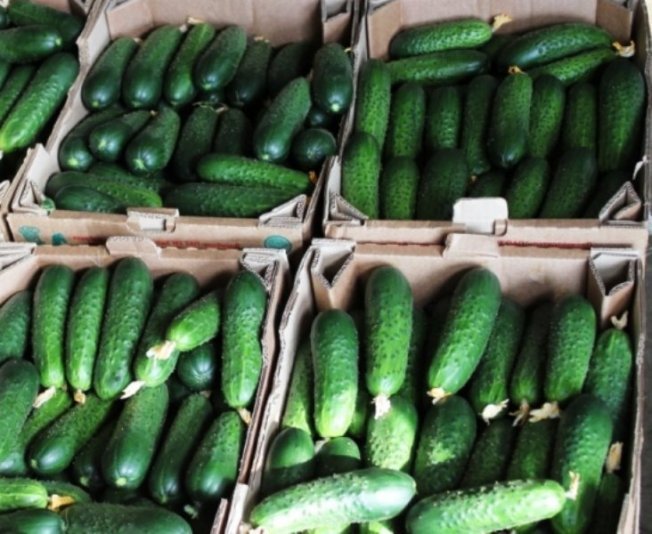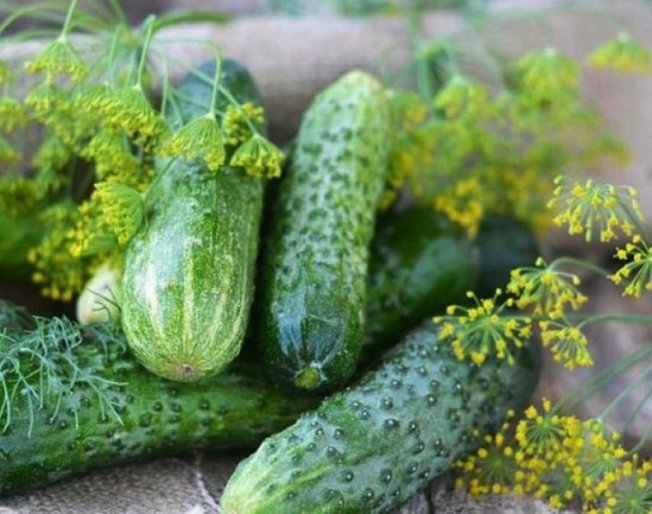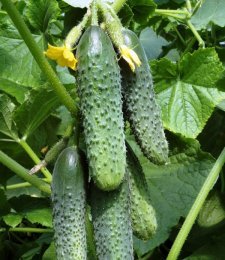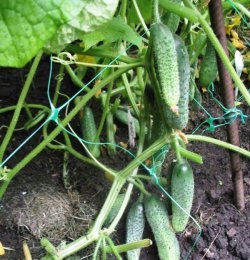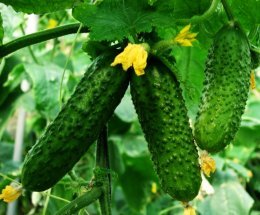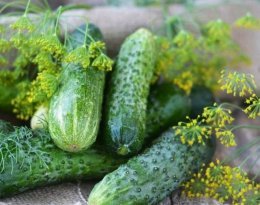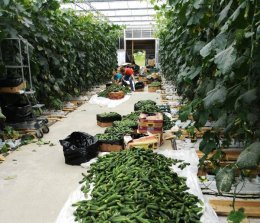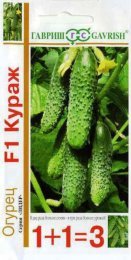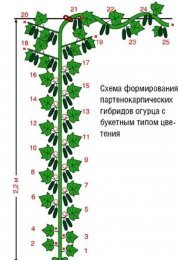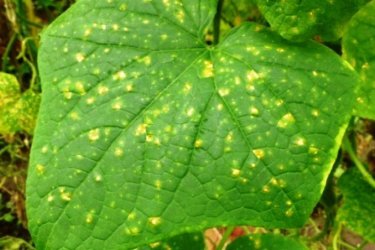Cucumber Courage f: description and reviews, photos, planting and care, advantages and features

In terms of popularity, cucumbers can rival any vegetable crop. The increased interest of farmers and amateur vegetable growers forces breeders to create new varieties and work to increase the yield and taste of fruits. Therefore, we get acquainted with another promising hybrid: cucumber Courage f1, its description, reviews, photos, planting and caring for the plant.
Content:
- Plant characteristics, photo
- Productivity
- Disadvantages and advantages of the variety
- Description of fruits
- Where to plant, what soil to use for beds
- Sowing seeds, planting seedlings
- Formation of bushes
- How to water cucumbers
- What and when to feed
- Disease control, preventive measures
- How to deal with insect pests
- How to collect and preserve the harvest
- Use in cooking
Plant characteristics
The cucumber variety Kurazh F1 is distinguished by strong roots and a powerful stem, the height of which can reach 3 or even more meters. The plant is not prone to actively forming shoots.
The formation of leaves is active, they are quite large, dark green in color, the teeth on the edge are barely noticeable.
Pollination by bees is not required for Courage; it is profitable to grow it in open and closed ground conditions. To obtain the highest possible yield, it is still recommended to give preference to growing in greenhouses or greenhouses.
The variety is early ripening and begins to bear fruit 40-50 days after emergence. The most active formation of fruits occurs in the first phase of fruiting.
Let's watch a video about KurazhF1 cucumbers, its yield, cultivation and care:
Productivity
It is recommended to grow the Courage F1 hybrid in the fields of small farms and private plots. The most attractive point is the possibility of obtaining a good harvest even in unfavorable weather conditions, but one cannot refuse proper care, especially timely feeding of plants.
The description of the Courage F1 cucumber and reviews from those who grew it, numerous photos, show that with good care, the formation of ovaries is very active; often a dozen greens, or even more, will grow on the stems at the same time.
You can harvest the first cucumbers as early as the 20th of June. If weather conditions allow you to plant seedlings in early May. Under suitable weather conditions, about 10 kg of greens can be harvested from a bush; from one square, the yield will be 15-20 kg.
Disadvantages and advantages of the variety
Let's start by describing the disadvantages of a hybrid, there is only one. And this is the need for proper care:
- timely watering;
- compliance with feeding deadlines;
- a reasonable approach to bush formation.
If you follow the recommendations, Courage will delight you with an abundance of greens that are excellent in taste and appearance.
As for the advantages of the variety, you will need to point out:
- ability to adapt to weather conditions, including droughts;
- high productivity;
- early onset of fruiting;
- friendly return of fruits;
- excellent taste, without bitterness, can be used in salted, fresh and pickled form:
- ability to maintain presentation after transportation;
- resistance to common diseases.
Kurazh cucumbers are grown for personal consumption and for sale; they retain their presentation quite well.
We invite you to watch an interesting video about growing Courage F1 cucumbers in a greenhouse and learn how to properly pinch side shoots:
Description of fruits
The ovaries on the stems are bouquets; they are formed in the leaf axils. Each “bouquet” can contain 3-6 fruits. A healthy bush can produce from 25 to 30 greens. The fruits are cylindrical, smooth, and moderately pimply. Light-colored stripes are visible on the longitudinal ribs. The weight of the fruit is 120-130 g, the diameter is from 3 to 4 cm, the length is within 15 cm. The fruits obtained from the side shoots are slightly smaller, their length barely reaches 10-12 cm.
The pulp of the fruit is tender, with a sweet aftertaste, aromatic, and is not inferior in taste to bee-pollinated varieties created for fresh consumption.
Where to plant, what soil to use for beds
You can grow Courage cucumbers, the descriptions and photos of which we are considering, indoors and outdoors. Greenhouse plants will allow you to get a higher yield. Maximum yield can be obtained by growing the hybrid in seedlings.
Plants can be grown both on the ground and on trellises; in greenhouse conditions it is better to use the second option. Trellis provide good ventilation of the beds and allow plants to receive maximum illumination. It is much easier to remove greens from stems tied to trellises; they are not contaminated with soil.
Cucumbers are planted in well-lit beds, on light, loose soil: black soil, forest gray soil, loamy or sandy loam soil.
It is recommended to plant cucumbers after legumes, nightshades or cabbage.
The soil in the beds is fertilized with humus, peat, and urea. For poor soils, layered beds are created, i.e. The dug trench is filled in layers:
- fallen leaves (8 cm);
- fertile soil (10 cm);
- compost (8 cm);
- a mixture of garden soil and peat.
Each layer is sprinkled with wood ash and mineral fertilizers, no more than 80 g per 1 square meter, and filled with plenty of water.
Before sowing the seeds, the area is filled with heated water and covered with plastic wrap.
Row spacing must be at least 0.5 m wide.
Sowing seeds, planting seedlings
If seedlings are grown in pots, the seeds are deepened by 1.5 - 2 cm, in open ground - by 3 cm. To increase germination, the seeds are soaked for two days in a solution of Epin, Potassium Humate, you can also add a weak solution of potassium permanganate to disinfect the seeds.
Cucumber beds should not be thickened: 2 square meters. m. you can place no more than 3 bushes.
Seedlings are planted on a cloudy day, or work begins in the evening.
When growing cucumbers in a greenhouse, after transplanting the seedlings, you will need to maintain high air humidity in it for 7 days. After planting the plants in open ground, you can cover them with special agrofibre.
Water the plants exclusively with settled, sun-warmed water, early in the morning or in the evening.
Formation of bushes
To get bouquet bud formation you will need to form lashes:
- remove shoots and ovaries in the axils of the 3 lower leaves;
- remove shoots in the axils of the next 3 leaves, but leave the ovaries;
- pinch the side shoots that appear above;
- Pinching the top after it reaches the ceiling of the greenhouse (or the top of the trellis).
To prevent the plant from experiencing stress, do not remove more than 3-4 shoots or leaves at a time.
How to water plants
The volume of the harvest largely depends on the quality of irrigation. Even adult plants need to be watered with water heated in the sun; the volume of liquid per bush is at least 5 liters per day. A greater effect is achieved by watering the entire bed, rather than water applied specifically to the bush. Some water savings can be achieved by watering the grooves formed between the bushes.
The frequency of watering is adjusted taking into account the frequency of rainfall and air temperature. In too hot weather, watering can be done daily, per 1 square meter. per meter of area you need to spend from 10 to 13 liters of water.
What and when to feed
During the period of growth and development and fruiting, a cucumber requires at least 4 feedings:
- 1st, 15 days after planting the seedlings, use a solution of infusion of chicken droppings, green grass or manure;
- 2nd, timed to the beginning of flowering, water with a solution of grass infusion, or add a mixture of potassium and ammonium nitrate with superphosphate and wood ash to the soil;
- 3rd, when fruiting begins, carry out foliar feeding with a solution of urea, or add a solution of urea and potassium nitrate to the soil;
- 4th, two weeks after the previous one, use an infusion of ash, rotted hay, baking soda, or perform foliar feeding with a urea solution.
Disease control, preventive measures
Courage F1 cucumbers are resistant to real and downy mildew, olive spot, root rot, and mosaic.
However, we will indicate what diseases vegetable growers should be wary of, and for clarity, we will compile a table.
| Name of the disease | Symptoms | Prevention |
| Cladosporiosis | Gray and brown spots on the leaves, death of the affected tissues, formation of holes on the leaves at the site of the lesion, acquisition of an unpleasant taste by the fruits | Spraying with Bordeaux mixture solution, ventilation of greenhouses |
| Sclerotinia, or white rot | White spots on all parts of the plant, wateriness of the affected areas | Removing affected leaves and stems, or the entire plant, monitoring soil moisture, sprinkling slaked lime in the holes that remain after removing diseased bushes |
| Ascochyta blight | Brown, beige, brownish spots on leaves, death of affected areas, deformation of fruits | Spraying with Bordeaux mixture or modern fungicides |
| Fusarium | Very rapid wilting of bushes | Spilling the beds with a solution of potassium permanganate before planting plants |
| White cucumber mosaic | Whitish spots on leaves, thin white stripes on fruits | There are currently no preventative or control measures |
How to deal with insect pests
Like other varieties of cucumbers, Kurazh is susceptible to attacks by harmful insects.
Colonies of black and green aphids can cause a lot of damage to plants. Insects can be seen with the naked eye; they settle in large groups, sucking juices from young shoots and leaves. Insecticides will help get rid of aphids: Strela, Inta_Vir, etc. Folk remedies include spraying with infusion of ash, tobacco, hot pepper, garlic, and tomato tops.
When attacked by a spider mite, the leaves become covered with whitish cobwebs, lose color, turn yellow and crumble. For treatment, acaricides such as Acartan, Phosfamide, Zolon, etc. can be used.The drugs must be alternated; arachnids can develop immunity to the effects of toxic substances. You can also test the effectiveness of folk remedies, such as infusion of dandelions, yarrow or celandine herb.
Affected by the greenhouse whitefly, plants become covered with a white sticky mass, under its influence the process of photosynthesis slows down, the lashes and leaves turn black. To combat the pest, the drug Actofit is used.
If yellowish lines appear on the leaves, merging into pale spots with jagged edges, then most likely the plants have suffered from thrips. To combat them, use a solution of Actellik or Karbofos. As a folk remedy, we can recommend spraying with red pepper infusion.
How to harvest and preserve the harvest
Contrary to the opinion of botanists, culinary specialists classify cucumbers as vegetables.
The trays are removed when green; cucumbers should not be left to ripen since they are hybrids. then plants obtained from their own seeds will not have the proper qualities.
Cucumbers are harvested daily, in the morning or evening.
Since Courage is a hybrid, it is not recommended to collect seeds from it for planting. All fruits that have reached 10 cm in length are picked.
Store the fruits in a cool, dark place. A cellar with a temperature in the range of +5-10 C and high humidity can be considered ideal.
For storage, use boxes or boxes; the greens are laid out in one layer.
Use in cooking
Cucumbers are consumed fresh, as part of salads. They can be canned and pickled. Lightly salted fruits are very tasty and crispy.
Reviews
Here are some reviews from the forums of vegetable growers and summer residents.
Inna Sergeevna, Pavlov Posad
Despite the very hot summer, the hybrid yield was good. I grow plants on trellises, I believe that the yield depends entirely on the quality of fertilizing. In the first year of cultivation, I added only organic matter; bouquet ovaries were not observed on all bushes. And now for 3 years I am pleased with the stable fruiting. Some difficulty in care is the need to pinch out the side shoots, but without this you will not get a strong bush.
Antonina, Ivanovo
Courage F1 cucumbers are my favorite, crispy, thin, even, the yield is consistently high. I close them in jars for the winter, and in the summer we use them to make salads with cabbage or tomatoes when they are ripe. I am very pleased with this variety, I bought seeds again and continue to grow them.
Alexandra Petrovna, Nikopol
I have been planting Courage F1 cucumbers for several years now. At first I grew it on the ground; it was possible to mulch the beds with straw. But now I’ve completely switched to the trellis version, I like it much better, it’s easier to collect fruits, easier to water and feed. I strictly follow the recommendations for bush formation, otherwise there will be no good yield.
Cucumber Courage f1, with proper care, is superior in yield to other popular varieties. Despite the specific agricultural cultivation techniques, many amateur vegetable growers prefer this particular hybrid and recommend it for planting.

